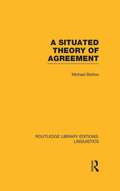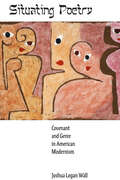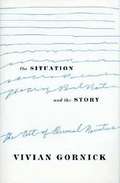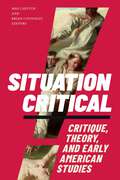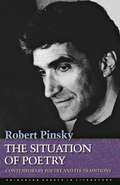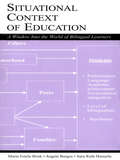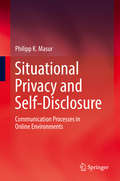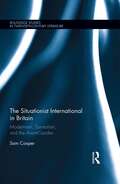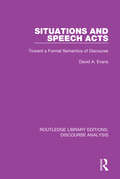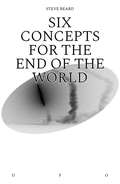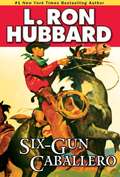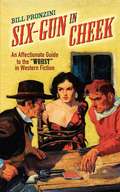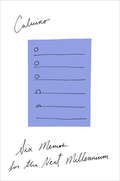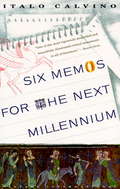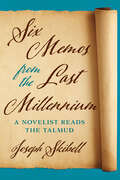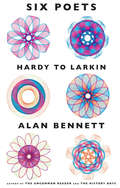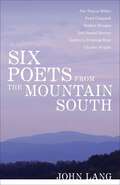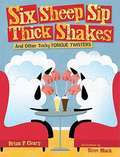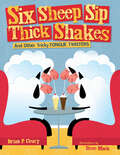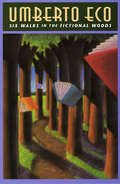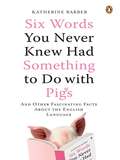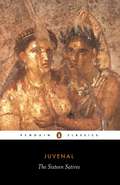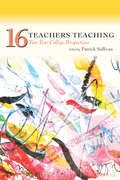- Table View
- List View
A Situated Theory of Agreement (Routledge Library Editions: Linguistics)
by Michael BarlowTypical cases of agreement are easy to identify, but where the boundaries of agreement lie depend on what aspects of the agreement relation are considered to be defining properties. It is a short step from viewing agreement in the traditional way, as a matching of features, to defining agreement as any relation that ensures consistency of information in two separate structures. This book takes as its topic agreement as it is traditionally conceived, one that only involves morphosyntactic categories.
Situating Poetry: Covenant and Genre in American Modernism
by Joshua Logan WallA retelling of American modernism through the lines of solidarity and division within and among ethnic and religious identities found in poetry.What happens if we approach the reading and writing of poetry not as an individual act, but as a public one? Answering this question challenges common assumptions about modern poetry and requires that we explore the important questions that define genre: Where is this poem situated, and how did it get there?Joshua Logan Wall's Situating Poetry studies five poets of the New York literary scene rarely considered together: James Weldon Johnson, Charles Reznikoff, Lola Ridge, Louis Zukofsky, and Robert Hayden. Charting their works and careers from 1910–1940, Wall illustrates how these politically marginalized writers from drastically different religious backgrounds wrestled with their status as American outsiders. These poets produced a secularized version of America in which poetry, rather than God, governed individual obligations to one another across multiethnic barriers.Adopting a multiethnic and pluralist approach, Wall argues that each of these poets—two Black, two Jewish, and one Irish-American anarchist—shares a desire to create more truly democratic communities through art and through the covenantal publics created by their poems despite otherwise sitting uncomfortably, at best, within a more standard literary history. In this unique account of American modernist poetics, religious pluralism creates a lens through which to consider the bounds of solidarity and division within and among ethnic identities and their corresponding literatures.
The Situation and the Story: The Art of Personal Narrative, New Edition for Writers, Teachers, and Students
by Vivian GornickA guide to the art of personal writing, by the author of Fierce Attachments and The End of the Novel of Love All narrative writing must pull from the raw material of life a tale that will shape experience, transform event, deliver a bit of wisdom. In a story or a novel the "I" who tells this tale can be, and often is, an unreliable narrator but in nonfiction the reader must always be persuaded that the narrator is speaking truth. How does one pull from one's own boring, agitated self the truth-speaker who will tell the story a personal narrative needs to tell? That is the questionThe Situation and the Story asks--and answers. Taking us on a reading tour of some of the best memoirs and essays of the past hundred years, Gornick traces the changing idea of self that has dominated the century, and demonstrates the enduring truth-speaker to be found in the work of writers as diverse as Edmund Gosse, Joan Didion, Oscar Wilde, James Baldwin, or Marguerite Duras. This book, which grew out of fifteen years teaching in MFA programs, is itself a model of the lucid intelligence that has made Gornick one of our most admired writers of nonfiction. In it, she teaches us to write by teaching us how to read: how to recognize truth when we hear it in the writing of others and in our own.
Situation Critical: Critique, Theory, and Early American Studies
by Max Cavitch and Brian Connolly, eds.The contributors to Situation Critical argue for the continued importance of critique to early American studies, pushing back against both reductivist neo-empiricism and so-called postcritique. Bringing together essays by a diverse group of historians and literary scholars, editors Max Cavitch and Brian Connolly demonstrate that critique is about acknowledging that we are never simply writing better or worse accounts of the past, but accounts of the present as well. The contributors examine topics ranging from the indeterminacy of knowledge and history to Black speculative writing and nineteenth-century epistemology, the role of the unconscious in settler colonialism, and early American writing about masturbation, repression, religion, and secularism and their respective influence on morality. The contributors also offer vital new interpretations of major lines of thought in the history of critique—especially those relating to Freud and Foucault—that will be valuable both for scholars of early American studies and for scholars of the humanities and interpretive social sciences more broadly.Contributors. Max Cavitch, Brian Connolly, Matthew Crow, John J. Garcia, Christopher Looby, Michael Meranze, Mark J. Miller, Justine S. Murison, Britt Rusert, Ana Schwartz, Joan W. Scott, Jordan Alexander Stein
The Situation of Poetry: Contemporary Poetry and Its Traditions (Princeton Essays in Literature #3)
by Robert PinskyIn this book Robert Pinsky writes about contemporary poetry as it reflects its modernist and Romantic past. He isolates certain persistent ideas about poetry's situation relative to life and focuses on the conflict the poet faces between the nature of words and poetic forms on one side, and the nature of experience on the other. <P><P>The author ranges for his often surprising examples from Keats to the great modernists such as Stevens and Williams, to the contents of recent magazines. He considers work by Ammons, Ashbery, Bogan, Ginsberg, Lowell, Merwin, O'Hara, and younger writers, offering judgments and enthusiasms from a viewpoint that is consistent but unstereotyped. Like his poetry, Robert Pinsky's criticism joins the traditional and the innovative in ways that are thoughtful and unmistakably his own. His book is a bold essay on the contemporary situation in poetry, on the dazzling achievements of modernism, and on the nature or "situation" of poetry itself.
Situational Context of Education: A Window Into the World of Bilingual Learners
by Mar¡a Estela Brisk Angela Burgos Sara Ruth HamerlaThis book gives educators important answers to the urgent question of how teachers and schools can facilitate language minority and immigrant students' progress in school. It offers an innovative and powerful method teachers and students can use to study the situational context of education, providing both the theoretical background and the practical tools to implement this approach. The situational context of education includes linguistic, economic, social, cultural, and political factors, as well as conditions, such as students' personal characteristics, family support, and quality of instruction. All of these factors influence the lives of students and their academic performance and contribute in many ways, some subtle and indirect, to making the educational experience more or less difficult for different students. The premise of the book is that objective study of the situational context of education by both students and teachers is beneficial because it leads to a more realistic view of how to facilitate students' progress in school. Designed as a text for graduate courses for preservice and in-service teachers working with students in bilingual, ESL, mainstream, and special education classrooms, the goal is to engage readers in learning not only from the literature but also from studying the situational contexts of their own students. The focus here is on the factors that affect language minority and immigrant students in the United States, but the framework is equally powerful for work with student populations in other social contexts. *The Introduction includes an overview of the theory behind the study of the situational context of education and the implementation of this approach; describes the context of the pilot lessons included in the book; and explains how to use the lessons detailed in later chapters. *Chapters 2-6 focus on different factors in the situational context of education: linguistic, economic, social, cultural, and political. A three-part structure is used: "Classroom Implementation" (a rich description of one lesson in a real classroom); "Context Variables" (a theoretical explanation of the specific factor the chapter addresses, providing the research basis for the sample lesson objectives ); "Doing Analysis of the Context" (several sample lessons for implementation). The lessons are addressed to the teacher, with detailed ideas on how to carry out the lesson and evaluate the students' understanding of the situational context. *Five Appendices provide helpful resources for the implementation of the lessons: an Annotated bibliography of relevant K-12 children's literature; Instructional Approaches; Scoring Rubrics for Content Objectives; Guidelines for a Contrastive Study of Situational Context; and Lesson Template. The lessons have been thoroughly field-tested with students and teachers. Because these lessons work on multiple levels, Situational Context of Education: A Window Into the World of Bilingual Learners benefits students from first grade through preservice and in-service teachers in university courses. Teachers get to know their students and their predicaments within the social context of the United States, and at the same time, the lesson activities have a great impact on the students in their classes. All are helped to achieve academically while gaining awareness of situational factors affecting their lives.
Situational Privacy and Self-Disclosure: Communication Processes in Online Environments
by Philipp K. MasurUsing both a theoretical argumentation and an empirical investigation, this book rationalizes the view that in order to understand people’s privacy perceptions and behaviors, a situational perspective needs to be adopted.To this end, the book is divided into three parts. Part I advances the theory of situational privacy and self-disclosure by discussing impacts of new information and communication technologies on traditional theories of privacy and self-disclosure. Based on five basic suppositions, it describes three major processes of the theory: pre-situational privacy regulations processes, situational privacy perception and self-disclosure processes, and post-situational evaluation processes. Next, Part II presents the application of the theory to smartphone-based communication. It first analyses how people choose certain communication environments on their smartphones, how they manipulate them, and how these external factors affect self-disclosure within these environments. It then details a multi-method study conducted to test the derived assumptions and discusses the obtained results. Part III reflects on the overall implications of the theory, summarizes the major findings and lastly considers possible extensions and perspectives on future research.Intended mainly for researchers in privacy and communication studies, the book offers privacy scholars a systematic review of both classic and contemporary theories of privacy and self-disclosure. At the same time, communication scholars benefit from an additional methodological discussion of the mobile experience sampling method, which provides an invaluable approach to measuring situational communication processes.
The Situationist International in Britain: Modernism, Surrealism, and the Avant-Garde (Routledge Studies in Twentieth-Century Literature)
by Sam CooperThis book tells, for the first time, the story of the Situationist International’s influence and afterlives in Britain, where its radical ideas have been rapturously welcomed and fiercely resisted. The Situationist International presented itself as the culmination of the twentieth century avant-garde tradition — as the true successor of Dada and Surrealism. Its grand ambition was not unfounded. Though it dissolved in 1972, generations of artists and writers, theorists and provocateurs, punks and psychogeographers have continued its effort to confront and contest the ‘society of the spectacle.’ This book constructs a long cultural history, beginning in the interwar period with the arrival of Surrealism to Britain, moving through the countercultures of the 1950s and 1960s, and finally surveying the directions in which Situationist theory and practice are being taken today. It combines agile historicism with close readings of a vast range of archival and newly excavated materials, including newspaper reports, underground pamphlets, Psychogeographical films, and experimental novels. It brings to light an overlooked but ferociously productive period of British avant-garde practice, and demonstrates how this subterranean activity helps us to understand postwar culture, late modernism, and the complex internationalization of the avant-garde. As popular and academic interest in the Situationists grows, this book offers an important contribution to the international history of the avant-garde and Surrealism. It will prove a valuable resource for researchers and students of English and Comparative Literature, Modernism and the Avant-Gardes, Twentieth Century and Contemporary History, Cultural Studies, Art History, and Political Aesthetics.
Situations and Speech Acts: Toward a Formal Semantics of Discourse (RLE: Discourse Analysis)
by David A. EvansFirst published in 1985, this book aims to develop an approach to speech acts that has the virtue of being straight-forward, explicit, formal and flexible enough to accommodate many of the more general problems of interactive verbal communication. The first chapter introduces situation semantics with the second addressing the assumptions implied by the problem of representing speaker intentionality. The third chapter presents a streamlined theory of speech acts and the fourth tests the predictions of the theory in several hypothetical discourse situations. A summary and suggestions for further research is provided in chapter five, and appendices facilitate reference to key concepts.
Six Concepts for the End of the World (Goldsmiths Press / Unidentified Fictional Objects)
by Steve BeardA navigational aid to the apocalypse.Steve Beard's Six Concepts for the End of the World mixes scientific research with experimental fiction to produce a manual for the apocalypse. The author examines six disciplines—technology, sociology, geography, psychology, theology and narratology—and for each one creates a fictional scenario that both reflects and energizes the research, all under the guiding light of the philosopher Paul Virilio's theories. This approach allows Beard to create one surprising idea after another: Hollywood viewed as a research and development lab for the end times, a first-person account of a UFO abduction, a blog on the disappearance of the Malaysian Airlines flight 370, a voice-over for an imaginary film by a doomsday cult member. Highly original in both form and content, the book surprises and delights in its scope. The approach is multidisciplinary and multidirectional, and Beard's exploration ranges over many areas and themes, always bringing distinctive insights to bear. Six Concepts for the End of the World is an expertly guided tour through the author's imagination, and toward the end of the world.
Six-Gun Caballero
by L. Ron HubbardSaddle up for this adventure. Michael Patrick Obanon, proud owner of a 100,000-acre spread willed to him by his father, suddenly loses his entire inheritance when a band of criminals makes false claims on the ranch. Faced with having to save his property and his people, Obanon takes a courageous stand against the renegades.Yet he soon realizes it will take far more than mere weapons to win the day. With all guns seemingly drawn against him, Michael must come up with a devious strategy of his own to outwit the imposters and regain his birthright. "If proof were needed that L. Ron Hubbard could handle the Western with the flair of a Louis L'Amour or Zane Grey, this book is it." --True West Magazine
Six-Gun in Cheek: An Affectionate Guide to the "Worst" in Western Fiction
by Bill PronziniThis hilarious and informative study of "alternative Westerns" takes aim at sub-par cowboy fiction. Author Bill Pronzini presents hundreds of laughable one-liners and juicy excerpts of deliciously awful dialogue from pulp magazines of the 1920s and '30s as well as paperbacks of the '50s, '60s, and '70s. Pronzini also offers plot summaries, anecdotes, historical tidbits, and little-known facts about writers from the heyday of the horse opera. Discover the meaning of slang terms such as "slicker 'n slobbers" and "doogin pin" and marvel at a plot element "so bold, so dazzling, so casually insane" that it elevates Jackson Cole's Black Gold to the greatest of all alternative classic Western novels. Meet Chuck Martin, the writer who solemnly "buried" the characters he killed off in his stories in a private cemetery in his backyard, and get acquainted with a gallery of memorable fictional characters, including Ridin' Rand of the Rio Grande, the world's first rhinestone cowboy. The author of Gun in Cheek, a similarly affectionate send-up of crime fiction, Pronzini provides a comic survey that will delight all fans of popular Western fiction.
Six Memos for the Next Millennium (The\charles Eliot Norton Lectures #391)
by Italo CalvinoThe celebrated author of Cosmicomics and Invisible Cities shares his &“brilliant, original approach to literature&” in these late-career lectures (San Francisco Chronicle). At the time of his death, Italo Calvino was at work on his Charles Eliot Norton poetry lectures to be delivered the following year at Harvard University. The six planned lectures would define the qualities he most valued in writing, and which he believed would define literature in the century to come. Six Memos for the Next Millennium collects the five lectures he completed, forming not only a stirring defense of literature, but also an indispensable guide to the writings of Calvino himself. He devotes one &“memo&” each to the concepts of lightness, quickness, exactitude, visibility, and multiplicity, drawing examples from his vast knowledge of myth, folklore, and works both ancient and modern. Written in the mid-1980s, these lectures have proven to be astonishingly prescient as we have entered Calvino&’s &“next millennium&”. &“One of the most rigorously presented and beautifully illustrated critical testaments in all of literature.&”—Boston Globe &“A key to Calvino&’s own work and a thoroughly delightful and illuminating commentary on some of the world&’s greatest writing.&”—San Francisco Chronicle
Six Memos for the Next Millennium
by Italo Calvino Patrick CreaghSix Memos for the Millennium is a collection of five lectures Italo Calvino was about to deliver at the time of his death. Here is his legacy to us: the universal values he pinpoints become the watchwords for our appreciation of Calvino himself.What should be cherished in literature? Calvino devotes one lecture, or memo to the reader, to each of five indispensable qualities: lightness, quickness, exactitude, visibility, and multiplicity. A sixth lecture, on consistency, was never committed to paper, and we are left only to ponder the possibilities. With this book, he gives us the most eloquent defense of literature written in the twentieth century--a fitting gift for the next millennium.From the Trade Paperback edition.
Six Memos from the Last Millennium: A Novelist Reads the Talmud (Exploring Jewish Arts and Culture)
by Joseph SkibellA storyteller&’s take on the Talmud and the timeless wisdom contained within its tales provides &“a fresh look at an ancient source&” (Kirkus Reviews). A thief-turned-saint, killed by an insult. A rabbi burning down his world in order to save it. A man who lost his sanity while trying to fathom the origin of the universe. A beautiful woman battling her brother&’s and her husband&’s egos to preserve their family. Stories such as these enliven the pages of the Talmud, the great repository of ancient wisdom that is one of the sacred texts of the Jewish people. Comprised of the Mishnah, the oral law of the Torah, and the Gemara, a multigenerational metacommentary on the Mishnah dating from between 3950 and 4235 (190 and 475 CE), the Talmud presents a formidable challenge to understand without scholarly training and study. But what if one approaches it as a collection of tales with surprising relevance for contemporary readers? In Six Memos from the Last Millennium, Joseph Skibell, critically acclaimed author of A Blessing on the Moon and other novels, reads some of the Talmud&’s tales with a storyteller&’s insight, concentrating on the lives of the legendary rabbis depicted in its pages to uncover the wisdom they can still impart to our modern age. He unifies strands of stories that are scattered throughout the Talmud into coherent narratives or &“memos,&” which he then analyzes and interprets from his perspective as a novelist. In Skibell&’s imaginative and personal readings, this sacred literature frequently defies our conventional notions of piety. Sometimes wild, rude, and even bawdy, these memos from the last millennium pursue a livable transcendence, a way of fusing the mundane hours of earthly life with a cosmic sense of holiness and wonder.
Six Minutes a Day to Perfect Spelling
by Harry ShefterPeople make spelling mistakes simply because they have never formed the right spelling habits. Here is a proven method that will make you a master speller.
Six Poets
by Alan BennettThe inimitable Alan Bennett selects and comments upon six favorite poets and the pleasures of their works In this candid, thoroughly engaging book, Alan Bennett creates a unique anthology of works by six well-loved poets. Freely admitting his own youthful bafflement with poetry, Bennett reassures us that the poets and poems in this volume are not only accessible but also highly enjoyable. He then proceeds to prove irresistibly that this is so. Bennett selects more than seventy poems by Thomas Hardy, A. E. Housman, John Betjeman, W. H. Auden, Louis MacNeice, and Philip Larkin. He peppers his discussion of these writers and their verse with anecdotes, shrewd appraisal, and telling biographical detail: Hardy lyrically recalls his first wife, Emma, in his poetry, although he treated her shabbily in real life. The fabled Auden was a formidable and off-putting figure at the lectern. Larkin, hoping to subvert snooping biographers, ordered personal papers shredded upon his death. Simultaneously profound and entertaining, Bennett's book is a paean to poetry and its creators, made all the more enjoyable for being told in his own particular voice. its creators, made all the more enjoyable for being told in his own particular voice.
Six Poets from the Mountain South: Sherman's Troops in the Savannah and Carolinas Campaigns (Southern Literary Studies)
by John LangIn the most extensive work to date on major poets from the mountain South, John Lang takes as his point of departure an oft-quoted remark by Jim Wayne Miller: "Appalachian literature is -- and has always been -- as decidedly worldly, secular, and profane in its outlook as the [region's] traditional religion appears to be spiritual and otherworldly." Although this statement may be accurate for Miller's own poetry and fiction, Lang maintains that it does not do justice to the pervasive religious and spiritual concerns of many of the mountain South's finest writers, including the five other leading poets whose work he analyzes along with Miller's. Fred Chappell, Robert Morgan, Jeff Daniel Marion, Kathryn Stripling Byer, and Charles Wright, Lang demonstrates, all write poetry that explores, sometimes with widely varying results, what they see as the undeniable presence of the divine within the temporal world. Like Blake and Emerson before them, these poets find the supernatural within nature rather than beyond it. They all exhibit a love of place in their poems, a strong sense of connection to nature and the land, especially the mountains. Yet while their affirmation of the world before them suggests a resistance to the otherworldliness that Miller points to, their poetry is nonetheless permeated with spiritual questing. Dante strongly influences both Chappell and Wright, though the latter eventually resigns himself to being simply "a God-fearing agnostic," whereas Chappell follows Dante in celebrating "the love that moves the sun and other stars." Byer, probably the least orthodox of these poets, chooses to lay up treasures on earth, rejecting the transcendent in favor of a Native American spirituality of immanence, while Morgan and Marion find in nature what Marion calls a "vocabulary of wonders" akin to Emerson's conviction that nature is the language of the spiritual. Employing close readings of the poets' work and relating it to British and American Romanticism as well as contemporary eco-theology and eco-criticism, Lang's book is the most ambitious and searching foray yet into the worlds of these renowned post--World War II Appalachian poets.
Six Sheep Sip Thick Shakes: And Other Tricky Tongue Twisters
by Brian P. ClearyBrian P Cleary, author of the best-selling Words Are CATegorical series, displays his wacky wordplay in this fun book of tongue twisters. His silly sentences are sure to have you giggling, groaning, and guffawing. Playful art by Steve Mack adds to the fun. Plus, you'll find tips for creating your own tongue twisters! Test your tongue on these tricky twisters and see if it gets tied up in knots.
Six Sheep Sip Thick Shakes: And Other Tricky Tongue Twisters (Exceptional Reading And Language Arts Titles For Intermediate Grades Ser.)
by Brian P Cleary Steve MackFrom best-selling author Brian P. Cleary, Six Sheep Sip Thick Shakes is a real mouthful! Presenting readers with twenty-four challenging and hilarious tongue twisters, Cleary's inventive sentences and Steve Mack's appealing art will leave readers tongue-tied?and laughing through their teeth.
Six Walks in the Fictional Woods
by Umberto EcoIn this exhilarating book, we accompany Umberto Eco as he explores the intricacies of fictional form and method. Using examples ranging from fairy tales and Flaubert, Poe and Mickey Spillane, Eco draws us in by means of a novelist's techniques, making us his collaborators in the creation of his text and in the investigation of some of fiction's most basic mechanisms.
Six Words You Never Knew Had Something To Do With Pigs: And Other Fascinating Facts About The English Language
by Katherine BarberA delightfully addictive compendium of fascinating word facts that does for the dictionary what Eats, Shoots, and Leaves did for the manual of style. <P> With the easy erudition and lively wit that have won her legions of fans, Canada's "Word Lady" reveals the entertaining histories behind 500 of the most common words and phrases in the English language. Who knew that 'travel' is derived from an instrument of torture? That "tragedy" originally had something to do with goats? That "glamour" and "grammar" started out as the same word? <P> Katherine Barber's captivating collection is organized by season, so readers can open to Valentine's Day to learn about the origins of "passion fruit" or flip to Thanksgiving to find out why there aren't any turkeys in Turkey. An irresistible blend of entertainment and enlightenment, this delightful book will captivate the word lover in all of us.
Sixteen Modern American Authors: A Survey of Research and Criticism since 1972
by Jackson R. BryerPraise for the earlier edition:"Students of modern American literature have for some years turned to Fifteen Modern American Authors (1969) as an indispensable guide to significant scholarship and criticism about twentieth-century American writers. In its new form--Sixteenth Modern American Authors--it will continue to be indispensable. If it is not a desk-book for all Americanists, it is a book to be kept in the forefront of the bibliographical compartment of their brains."--American Studies
The Sixteen Satires
by JuvenalPerhaps more than any other writer, Juvenal (c. AD 55-138) captures the splendour, the squalor and the sheer energy of everyday Roman life. In The Sixteen Satires he evokes a fascinating world of whores, fortune-tellers, boozy politicians, slick lawyers, shameless sycophants, ageing flirts and downtrodden teachers. A member of the traditional land-owning class that was rapidly seeing power slip into the hands of outsiders, Juvenal also creates savage portraits of decadent aristocrats - male and female - seeking excitement among the lower orders of actors and gladiators, and of the jumped-up sons of newly-rich former slaves. Constantly comparing the corruption of his own generation with its stern and upright forebears, Juvenal's powers of irony and invective make his work a stunningly satirical and bitter denunciation of the degeneracy of Roman society
Sixteen Teachers Teaching: Two-Year College Perspectives
by Patrick SullivanSixteen Teachers Teaching is a warmly personal, full-access tour into the classrooms and teaching practices of sixteen distinguished two-year college English professors. Approximately half of all basic writing and first-year composition classes are now taught at two-year colleges, so the perspectives of English faculty who teach at these institutions are particularly valuable for our profession. This book shows us how a group of acclaimed teachers put together their classes, design reading and writing assignments, and theorize their work as writing instructors. All of these teachers have spent their careers teaching multiple sections of writing classes each semester or term, so this book presents readers with an impressive—and perhaps unprecedented—abundance of pedagogical expertise, teaching knowledge, and classroom experience. Sixteen Teachers Teaching is a book filled with joyfulness, wisdom, and pragmatic advice. It has been designed to be a source of inspiration for high school and college English teachers as they go about their daily work in the classroom. Contributors: Peter Adams, Jeff Andelora, Helane Adams Androne, Taiyon J. Coleman, Renee DeLong, Kathleen Sheerin DeVore, Jamey Gallagher, Shannon Gibney, Joanne Baird Giordano, Brett Griffiths, Holly Hassel, Darin Jensen, Jeff Klausman, Michael C. Kuhne, Hope Parisi, and Howard Tinberg
